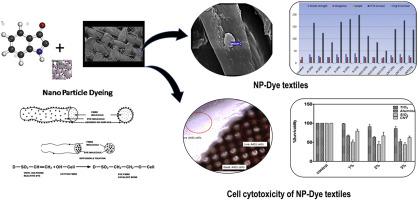当前位置:
X-MOL 学术
›
Mater. Today Chem.
›
论文详情
Our official English website, www.x-mol.net, welcomes your
feedback! (Note: you will need to create a separate account there.)
Controlled nano-particle dyeing of cotton can ensure low cytotoxicity risk with multi-functional property enhancement
Materials Today Chemistry ( IF 6.7 ) Pub Date : 2020-09-01 , DOI: 10.1016/j.mtchem.2020.100345 A. Khandual , N. Rout , S.K. Verma , P. Patel , P. Pattanaik , Y. Luximon , A. Kumar , R.K. Nayak , M. Suar
Materials Today Chemistry ( IF 6.7 ) Pub Date : 2020-09-01 , DOI: 10.1016/j.mtchem.2020.100345 A. Khandual , N. Rout , S.K. Verma , P. Patel , P. Pattanaik , Y. Luximon , A. Kumar , R.K. Nayak , M. Suar

|
Abstract The Nanoparticle (NP) and their oxides are being progressively used and expected to be more frequently used in textiles. Nanoparticle (NP) has higher toxicological risk than larger particles because of their physicochemical properties, chemical reactivity and biological activity. In fact, the stability of nano-oxide particles in the medium is always challenging as they lack functional groups to leverage upon textile materials directly. Thus, in many finishing processes, cross-linkers and/or adhesives are applied together with NP at the cost of inferior comfort, feel and fastness which tends to be toxic and prone to release NPs under common laundering, physical stress and sweat. This study shows that the diffusion of NPs into the fibre polymer matrix via dyeing technique could be much durable, safer in terms of cytotoxicity levels and easy to process for tailoring desired functional attributes. We studied the possibility of a simple application technique via dyeing of vinyl sulphone based reactive dye with four kinds of NPs followed by their cytotoxicity test using cell line A431.1% silica dyed sample have shown highest (198.5%) increase in tensile strength followed by 2% silica and 2% CNT whereas a decrease in elongation is highest in the case of CNT 2% (5.31%) and significantly enhancing the moisture management properties in case of CNT and silica. The study showed promising results in dyeing with TiO2, CNT (Carbon nanotubes), Silica and Alumina NPs in enhancing the mechanical, moisture management, and surface frictional properties to ensure comfortable and safe wear.
中文翻译:

棉花可控纳米粒子染色可确保低细胞毒性风险并增强多功能性能
摘要 纳米粒子 (NP) 及其氧化物正逐渐被使用,并有望更频繁地用于纺织品。纳米颗粒 (NP) 由于其理化性质、化学反应性和生物活性而具有比较大颗粒更高的毒理学风险。事实上,纳米氧化物颗粒在介质中的稳定性始终具有挑战性,因为它们缺乏直接利用纺织材料的官能团。因此,在许多整理过程中,交联剂和/或粘合剂与 NP 一起使用,代价是舒适度、手感和牢度较差,这往往是有毒的,并且在普通洗涤、物理压力和汗水下容易释放 NP。这项研究表明,通过染色技术将 NPs 扩散到纤维聚合物基质中可以非常耐用,在细胞毒性水平方面更安全,并且易于加工以定制所需的功能属性。我们研究了一种简单应用技术的可能性,即使用四种 NP 对乙烯基砜基活性染料进行染色,然后使用细胞系 A431.1% 二氧化硅染色样品进行细胞毒性测试,显示拉伸强度最高(198.5%),其次是2% 二氧化硅和 2% CNT 而伸长率的降低在 CNT 2% (5.31%) 的情况下最高,并且在 CNT 和二氧化硅的情况下显着增强了水分管理性能。该研究表明,在使用 TiO2、CNT(碳纳米管)、二氧化硅和氧化铝纳米粒子进行染色时,在增强机械、水分管理和表面摩擦性能方面取得了可喜的成果,以确保穿着舒适和安全。我们研究了一种简单应用技术的可能性,即使用四种 NP 对乙烯基砜基活性染料进行染色,然后使用细胞系 A431.1% 二氧化硅染色样品进行细胞毒性测试,显示拉伸强度最高(198.5%),其次是2% 二氧化硅和 2% CNT 而伸长率的降低在 CNT 2% (5.31%) 的情况下最高,并且在 CNT 和二氧化硅的情况下显着增强了水分管理性能。该研究显示,在使用 TiO2、CNT(碳纳米管)、二氧化硅和氧化铝纳米粒子进行染色时,在增强机械、水分管理和表面摩擦性能方面取得了可喜的成果,以确保穿着舒适和安全。我们研究了一种简单应用技术的可能性,即使用四种 NP 对乙烯基砜基活性染料进行染色,然后使用细胞系 A431.1% 二氧化硅染色样品进行细胞毒性测试,显示拉伸强度最高(198.5%),其次是2% 二氧化硅和 2% CNT 而伸长率的降低在 CNT 2% (5.31%) 的情况下最高,并且在 CNT 和二氧化硅的情况下显着增强了水分管理性能。该研究表明,在使用 TiO2、CNT(碳纳米管)、二氧化硅和氧化铝纳米粒子进行染色时,在增强机械、水分管理和表面摩擦性能方面取得了可喜的成果,以确保穿着舒适和安全。
更新日期:2020-09-01
中文翻译:

棉花可控纳米粒子染色可确保低细胞毒性风险并增强多功能性能
摘要 纳米粒子 (NP) 及其氧化物正逐渐被使用,并有望更频繁地用于纺织品。纳米颗粒 (NP) 由于其理化性质、化学反应性和生物活性而具有比较大颗粒更高的毒理学风险。事实上,纳米氧化物颗粒在介质中的稳定性始终具有挑战性,因为它们缺乏直接利用纺织材料的官能团。因此,在许多整理过程中,交联剂和/或粘合剂与 NP 一起使用,代价是舒适度、手感和牢度较差,这往往是有毒的,并且在普通洗涤、物理压力和汗水下容易释放 NP。这项研究表明,通过染色技术将 NPs 扩散到纤维聚合物基质中可以非常耐用,在细胞毒性水平方面更安全,并且易于加工以定制所需的功能属性。我们研究了一种简单应用技术的可能性,即使用四种 NP 对乙烯基砜基活性染料进行染色,然后使用细胞系 A431.1% 二氧化硅染色样品进行细胞毒性测试,显示拉伸强度最高(198.5%),其次是2% 二氧化硅和 2% CNT 而伸长率的降低在 CNT 2% (5.31%) 的情况下最高,并且在 CNT 和二氧化硅的情况下显着增强了水分管理性能。该研究表明,在使用 TiO2、CNT(碳纳米管)、二氧化硅和氧化铝纳米粒子进行染色时,在增强机械、水分管理和表面摩擦性能方面取得了可喜的成果,以确保穿着舒适和安全。我们研究了一种简单应用技术的可能性,即使用四种 NP 对乙烯基砜基活性染料进行染色,然后使用细胞系 A431.1% 二氧化硅染色样品进行细胞毒性测试,显示拉伸强度最高(198.5%),其次是2% 二氧化硅和 2% CNT 而伸长率的降低在 CNT 2% (5.31%) 的情况下最高,并且在 CNT 和二氧化硅的情况下显着增强了水分管理性能。该研究显示,在使用 TiO2、CNT(碳纳米管)、二氧化硅和氧化铝纳米粒子进行染色时,在增强机械、水分管理和表面摩擦性能方面取得了可喜的成果,以确保穿着舒适和安全。我们研究了一种简单应用技术的可能性,即使用四种 NP 对乙烯基砜基活性染料进行染色,然后使用细胞系 A431.1% 二氧化硅染色样品进行细胞毒性测试,显示拉伸强度最高(198.5%),其次是2% 二氧化硅和 2% CNT 而伸长率的降低在 CNT 2% (5.31%) 的情况下最高,并且在 CNT 和二氧化硅的情况下显着增强了水分管理性能。该研究表明,在使用 TiO2、CNT(碳纳米管)、二氧化硅和氧化铝纳米粒子进行染色时,在增强机械、水分管理和表面摩擦性能方面取得了可喜的成果,以确保穿着舒适和安全。







































 京公网安备 11010802027423号
京公网安备 11010802027423号